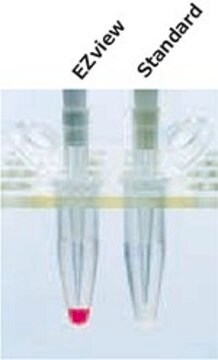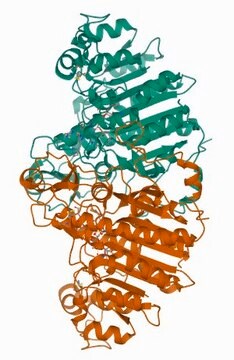A4596
ANTI-FLAG® M1 Agarose Affinity Gel
Sinónimos:
Anti-ddddk, Anti-dykddddk
About This Item
Productos recomendados
conjugado
agarose conjugate
Nivel de calidad
tipo de anticuerpo
primary antibodies
formulario
suspension
isotipo
IgG12b
capacidad
≥0.6 mg/mL, gel binding capacity
temp. de almacenamiento
−20°C
Descripción general
Especificidad
N-Asp-Tyr-Lys-Asp-Asp-Asp-Asp-Lys-C
Aplicación
Affinity gel is for calcium mediated purification of N-terminal FLAG fusion proteins.
immunoprecipitation (IP): suitable
Elution - FLAG peptide, Glycine, pH 3.5 EDTA
Learn more product details in our FLAG® application portal.
Características y beneficios
- Typically purify fusion proteins from crude lysates to single band purity in just one chromatography step.
- Fusion protein may be eluted from affinity resin by mild elution with EDTA.
- A solution of FLAG peptide can be used for gentle, non-denaturing elution of FLAG fusion proteins.
Forma física
Otras notas
Información legal
¿No encuentra el producto adecuado?
Pruebe nuestro Herramienta de selección de productos.
Producto relacionado
Código de clase de almacenamiento
10 - Combustible liquids
Clase de riesgo para el agua (WGK)
WGK 3
Punto de inflamabilidad (°F)
Not applicable
Punto de inflamabilidad (°C)
Not applicable
Certificados de análisis (COA)
Busque Certificados de análisis (COA) introduciendo el número de lote del producto. Los números de lote se encuentran en la etiqueta del producto después de las palabras «Lot» o «Batch»
¿Ya tiene este producto?
Encuentre la documentación para los productos que ha comprado recientemente en la Biblioteca de documentos.
Los clientes también vieron
Contenido relacionado
Protein purification techniques, reagents, and protocols for purifying recombinant proteins using methods including, ion-exchange, size-exclusion, and protein affinity chromatography.
Protein expression technologies for expressing recombinant proteins in E. coli, insect, yeast, and mammalian expression systems for fundamental research and the support of therapeutics and vaccine production.
Nuestro equipo de científicos tiene experiencia en todas las áreas de investigación: Ciencias de la vida, Ciencia de los materiales, Síntesis química, Cromatografía, Analítica y muchas otras.
Póngase en contacto con el Servicio técnico














